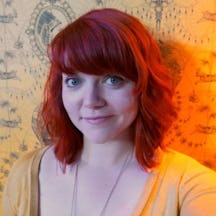Science fiction is full of giant lizards, evil machines and malformed mutants. But the scariest monsters of all are those that resemble humans – or, rather, humans with something chillingly wrong at heart.
Why the scariest monsters look almost human
Words by Amy Jonesphotography by Benjamin Gilbertaverage reading time 4 minutes
- Article

My first panic attack was caused by holes. I was a teenager clicking around online when I saw an image of someone’s chest covered in deep, cavernous holes. It was an unpleasant picture, but my reaction to it was far beyond that. No matter how I tried, I couldn’t stop the image from swimming behind my eyes and I had nightmares about it for weeks.
Although trypophobia isn’t officially recognised by medical bodies, a 2013 study from the University of Essex suggest that nearly 20 per cent of people suffer from it. It can cause anything from feeling itchy and uncomfortable to having a full-blown panic attack.
Photoshopped images of holes covering the body, like the one that first triggered me, are incredibly popular online – partly because some people like to make things to taunt trypophobes, but also because even non-sufferers are grimly fascinated by the images of tiny, monstrous holes taking over someone’s body. It feels fundamentally wrong somehow, and sticks with me in a way nothing else does.
Uncanny valley
As humans, we have a strong idea of how other humans should ‘work’ and any deviation from that idea is deeply unsettling. You can see this with the ‘uncanny valley’ phenomenon, where people react extremely negatively to robots or mannequins because of their disturbing, almost-human qualities. They seem human, but something is wrong, so they’re repulsive, threatening in a unique way.

Sci-fi has been using this effect on us for years. There have been thousands of monsters in sci-fi, but the ones that stick in our minds aren’t the bug-eyed aliens, rather it’s those that seem human but subvert it somehow. Much of this is to do with behaviour – when you think about what’s scary about a zombie, the fact that they want to eat you is fairly high on the list. But it’s also that so many of these creatures inhabit almost-human bodies, which disturbs us just as those photoshopped images of hole-covered hands do.
More: The science that shows we’re all capable of murderous thoughts.
Let’s stick with zombies. The idea of undead creatures has been around for a long time, like those in Haitian folklore, but it wasn’t until the West added a shuffling, rotting body to go with it, primarily from the 1920s onwards, in fiction by writers like H P Lovecraft and Edgar Rice Burroughs, that they became such objects of fear. Seeing life where we understand there should be death is terrifying, and so fascinating that we’re still making films and writing books about zombies years later.
Other monsters subvert human life too. Bram Stoker’s Dracula is terrifying long before we know he’s a vampire. Described as incredibly old and pale, but tall and strong, with pointed teeth and bright red lips “whose remarkable ruddiness showed astonishing vitality in a man of his years”, Dracula perverts what it means to age and it feels wrong. His physical effect was so chilling that it’s become the archetype for almost all vampires since.
Doctor Who and the almost-human
The BBC television series ‘Doctor Who’ is absolutely full of examples of human-but-not. This is partly due to excellent writers, but also down to a lack of budget, so many of the monsters are, very simply, twists on a human. Take the Cybermen, for example – human bodies wrapped up in cold, unfeeling, impenetrable steel whose clunking walk and blank eyes stay with you for far longer than the death and destruction they cause does.

But my favourite example is the ‘Doctor Who’ episode ‘The Empty Child’ by Steven Moffat. A little boy wandering round the Blitz in a gas mask and calling for his mummy is everything that should make us feel protective, so the sudden realisation that the boy’s mask is fused to his face and he’s a danger to us is incredibly sinister.
The end of this storyline is not with the death of the Empty Child, but with him being fixed by nanobots – tech that doesn’t understand what humanity is, but that can take a human body and reset it back to normal. The body goes back to what we expect, and we have our happy ending. A child isn’t scary when it looks and acts the way we expect a child to.
Of course, it’s possible to be a nightmarish sci-fi monster without being humanoid. The Daleks from ‘Doctor Who’, the Chestburster from the film ‘Alien’ and Godzilla are all in the sci-fi halls of fame without having a shred of humanity to them. But they don’t weigh on us or fascinate us in the same way as creatures that are so like us, yet so far away.
We love aliens and tales of ghouls from the deep, but the thing that makes a monster truly terrifying is its humanity.
About the contributors
Amy Jones
Amy Jones is a writer and AV producer who lives in London. She’s also one half of the storytelling podcast And Then What?
Benjamin Gilbert
Ben is a senior photographer for Wellcome. He is happiest when telling stories with his photographs, whether that be the health implications of rural-to-urban migration in India, or the dedication of the workers who power the NHS.

